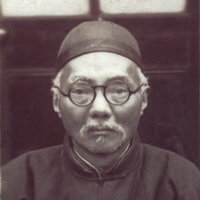Views
Hú Zǐhù 胡子笏 (1864-1943)
|
| Notable Associates: |
|
Hú Zǐhù 胡子笏 (1864-1943) was an active lay Buddhist who was instrumental in the establishment of a number of seminaries and other Buddhist institutions during the Republican period. He was also a student of Tibetan Esoteric Buddhism 西密.
Contents |
Biography
Hú received a traditional education growing up, and traveled to Japan to study during the middle years of the Guāngxù 光緒 period (1875-1908). There he became a revolutionary and graduated from Meiji University 明治大學 in politics and economics. In the closing years of Guāngxù he returned to China, becoming a leading industrialist in Wǔhàn 武漢.
After the 1911 uprising in Wǔchāng 武昌, Hú became an officer in the newly formed government. He moved from post to post over the next eight years, taking responsibility for a number of major offices.
In September of 1919, Hú attended a lecture on the Vimalakīrti Sūtra 維摩詰經 given in Běijīng 北京 by Tàixū 太虛. During this lecture, Hú had an awakening experience and afterward took refuge under Tàixū. This experience had a significant effect on his life, and he became a vegetarian, and otherwise began following the moral prescripts of Buddhism. In September of the following year (1920), Hú and some associates sponsored a lecture series given by Tàixū at Guǎngjì Temple 廣濟寺 in Běijīng.
In 1921, Hú assisted in the establishment of the Wǔchāng Buddhist Seminary 武昌佛學院, and later the Right Faith Society 正信會. He also served as the president of the Wǔhàn Young Men's Buddhist Association 武漢佛化青年會, and the principle of the Běipíng Women's Buddhist Seminary 北平女子佛學院.
In 1924, Hú became interested in Esoteric Buddhism and was instrumental in assisting Dàyǒng 大勇 establish his Tibetan Language College 藏文學院 in Běijīng, as well as in supporting the students of that school when they became in the Residing-in-Tibet Dharma Studies Group 留藏學法團, which left for Tibet in 1925. On November 1 and 2 of that same year, Hú served as one of the leaders of the Chinese delegation to the East Asian Buddhist Conference 東亞佛教大會 held in Tōkyō.
In 1926, he was elected as the controller of the nascent Northern China Buddhist Lay Association 華北佛教居士林.[1]
In September of 1929, Hú provided financial assistance for the establishment of the Bǎilín Institute 柏林教理院, which opened the following year.
With the outbreak of the Second Sino-Japanese War in 1937, Hú and his family moved to Mt. Wǔtái 五台山. There, Hú learned from the Tibetan lamas an esoteric technique called "the edible stone" (cānshí 餐石)[2], which allows one to use water, stones, ash, and a little milk to become full after eating only tiny amounts food. He recorded his experiences of using this technique in the "Diary of the Edible Stone (Cānshí rìjì 餐石日記)," which was published in 1934 and 1935 in Hǎicháo yīn 海潮音 and Shānxī fójiào zázhì 山西佛教雜誌. While on the mountain, Hú and his three daughters also studied Tibetan language.
In 1941, Hú was asked to become the principle of Běijīng's Mahāyāna Buddhism Propagation Seminary 大乘佛教弘化院, which had been established to provide education for the monks in Northern China's hereditary temples. Nearly one hundred monks took the entrance exam in September of that year, and began a four-month term as a "Buddhist Propagation Class (佛教弘化班)." Students graduated into the "Research Class (研究班)" on March of 1942. Hú returned to Běiijng in the fall of 1942 and set up a Tibetan language class at the Institute. He died the following year.
Important Works
- Cānshí rìjì 餐石日記 (Diary of the Edible Stone)
Notes
- ↑ Shì Dōngchū 釋東初. Zhōngguó Fójiào jìndài shǐ 中國佛教近代史 (A History of Early Contemporary Chinese Buddhism), in Dōngchū lǎorén quánjí 東初老人全集 (Complete Collection of Old Man Dongchu), vols. 1-2. Taipei: Dongchu, 1974 Pp. 1.247.
- ↑ Clearly Yú is wrong on the dating here, as the publication dates of is article on this technique show that he already knew it before traveling to Mt. Wǔtái.
References
- Shì Dōngchū 釋東初. Zhōngguó Fójiào jìndài shǐ 中國佛教近代史 (A History of Early Contemporary Chinese Buddhism), in Dōngchū lǎorén quánjí 東初老人全集 (Complete Collection of Old Man Dongchu), vols. 1-2. Taipei: Dongchu, 1974 Pp. 2.705-707.
- Tuttle, Gray. Tibetan Buddhism in the Making of Modern China. New York: Columbia University Press, 2005. Pp. 82, 84, 105, 213.
- Yú Língbō 于凌波, ed. Xiàndài Fójiào rénwù cídiǎn 現代佛教人物辭典 (A Dictionary of Modern Buddhist Persons), 2 vols. Taipei: Foguang, 2004. Pp. 1.780b-783b.
